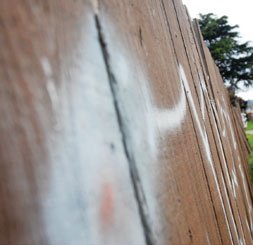Unchecked graffiti spreads like kudzu. Just ask any police
officer or take a stroll through downtown, or walk behind
practically any strip mall in Gilroy.
Unchecked graffiti spreads like kudzu.
Just ask any police officer or take a stroll through downtown, or walk behind practically any strip mall in Gilroy.
“It’s everywhere,” said Laura Wrede, a downtown resident who carries city-issued paint remover in her trunk after recently joining the volunteer ranks of the Gilroy’s graffiti clean-up crew.
She started on her own a couple years ago, but now more than ever, police say Wrede and dozens of other residents like her are key to containing the midnight mischief of taggers who deface storefronts, homes, light poles, utility boxes and other property. That’s because Community Services Officer Rachel Munoz is alone juggling more than 300 graffiti complaints a month on top of animal control calls, neighborhood watch issues and other responsibilities. Her deluge of responsibilities is in part due to layoffs earlier this year that forced Gilroy to let go of its part-time graffiti officer, Angela Locke-Paddon. An additional support officer is also set to go in June.
“We’re starting to see the visible signs of the cuts the city council approved,” Sgt. Wes Stanford said. “It’s not going to get better unless we have the staffing or if the community wants to start this wave of volunteerism.”
The City Council has acknowledged the problem and directed Police Chief Denise Turner to keep looking for grant money to possibly re-hire Locke-Paddon.
“There’s no question that graffiti is on the increase and it is more visible. We’re aware that it’s growing, and the council is now exploring its options to try and nip it in the butt,” Councilman Perry Woodward said, adding that Munoz and others, for now, “are dealing with it on a catch as can catch basis.”
Munoz – a short, spunky woman whose seemingly endless task breeds frustration among her colleagues and volunteers – recognizes her efforts alone are not enough to stop vandalism and she lauded volunteers such as Wrede and Eugene Elliot, a senior citizen who the Chamber of Commerce will recognize April 15 for cleaning up “his” area near Sixth and Monterey streets. For areas without such devoted erasers, though, Munoz said vandals see opportunities rather than budget cuts.
“Graffiti left up acts like a crime magnet,” she said.
David Anthony Dimas, 19, and a 15-year-old were drawn into that magnet when police arrested them a couple weeks ago behind the First Street shopping center that houses Mama Mia’s. An officer patrolling the rear saw them near a large trash bin in a back alley and discovered upon consensual contact that they were concealing spray paint cans with colors that matched still-wet graffiti nearby, according to Sgt. Stanford. Police charged both with vandalism, and the juvenile was also charged with underage possession of spray paint, but age requirements are obviously not enough, Munoz said.
“Where are the parents?” she asked with a huff. “We need to get to the root of this.”
Addressing the symptoms costs the city more than $125,000 a year. The police department annually shells out about $25,000 to Personal Impressions, a company that quickly wipes out serious vandalism and gang-related scrawling. Munoz helps when she can, and the city’s streets and landscape departments spends an additional $100,000 on supplies and city personnel to clean up parks and signs, according to Finance Director Christina Turner.
For most businesses, though, graffiti costs them.
Janet Blum arrived at work last week to see tagging on a van and the side of a building near Monterey and First streets. An employee called police, but Blum said nobody there had the time or patience to come out, and Munoz said she was busy dealing with a barrage of other graffiti complaints, so Blum acted herself.
“It wouldn’t have gotten cleaned up otherwise,” said Blum, who actually chased a tagger all the way to South Valley Middle School seven years, she said. The police eventually caught the child, thanks to her help.
Next door at NAPA Auto Parts, owner Wendyl Steiner said he relishes the day he will catch one of the taggers that occasionally deface his store.
“I’d love to catch them,” Steiner said. “They wouldn’t be using those hands anymore, I can tell you that much.”
While it can be annoying, expensive and unfair, Munoz encouraged property owners to “stand fast” and wipe out graffiti as soon as possible.
“No matter how frustrated they get, we have to show the perpetrators we’re not going to allow them to display their graffiti monikers on their property,” Munoz said. “Otherwise they go around bragging to each other.”
But Munoz stressed also that handcuffs and paint remover are not the solutions: Parents need to intervene and look for warning signs in their children, such as paint-stained clothes and etching tools, she said.
When her son, Josh, was younger, Wrede said she noticed his artistic tendencies spilling onto public property. Josh, 29, is now a tattoo artist and designer for music groups.
“Now he’s painting on the right surfaces,” Wrede said. “When he was younger, though, he was still an artist and thought tagging was a way to express his art, but we did not agree with that.”
While “tagging crews” account for about 85 percent of taggings, only 15 percent are gang-related, according to Sgt. Jim Gillio. Wrede recognizes this and also has her son as anecdotal proof, but she still said property deserves respect – no matter what.
“Not all the kids out there are trying to purposely do damage and commit crimes, but there is that element out there, and when you’re kids get involved, they need to realize it’s not art – it’s someone’s property,” Wrede said.
HOW TO GET INVOLVED
– Wipe-out-Watch volunteers meet the first Wednesday of every month at 12 p.m. at the Gilroy Police Station, 7301 Hanna St.
– Residents can call the 24-hour Graffiti Hotline at 846-0395 to report vandalism
– Residents can pick up recycled paint, brushes and other materials at the police station, or e-mail Rachel Munoz at ra**********@**********ca.us
Is your child a tagger?
Your child stays out until early morning or all night.
Your child frequently wears a large backpack or baggy pants as packs and loose clothing can be used to hold spray paint cans or carry graffiti tools. Clothing may be paint stained.
Your child carries tools used for etching glass, such as hole punches, rocks, glass cutters, screw drivers, awls, metal scribes or other sharp objects. (Your child may not be able to explain exactly why he or she has this in their possession).
Your child has large quantities of magic markers, shoe polish containers, or other devices used for drawing.
Your child sleeps during the day and is active outdoors at night.
Your child has paint on the tips of his/her fingers.
Your child frequently has permanent marker stains on his/her hands.
Your child has graffiti magazines, flyers, a “piece book” or other portfolio of tags.
Your child possesses large quantities of “My Name Is” stickers or other large stickers used for “sticker tagging.”
Your child is in possession of graffiti paraphernalia such as markers, etching tools, spray paint, bug spray and starch cans, but does not have the income to afford it. The bug spray cans are used to make tags that will only show up in the rain.
Your child is in the age group statistically associated with tagging – ages 12-18 (sometimes older).
Your child has graffiti displays or tags on clothing, binders, backpacks or the underside of the bill of their hat.
Tags you see on the walls of your neighborhood are seen on your child’s walls, books and clothing.
Your child is frequently deceitful about his/her activities.
Your child associates with other children with the traits described above.
Your child’s Internet Web browser has bookmarks to graffiti advocate web sites.
Your child has photographs of graffiti and tags on walls that look familiar to you.
Source: City of Gilroy













